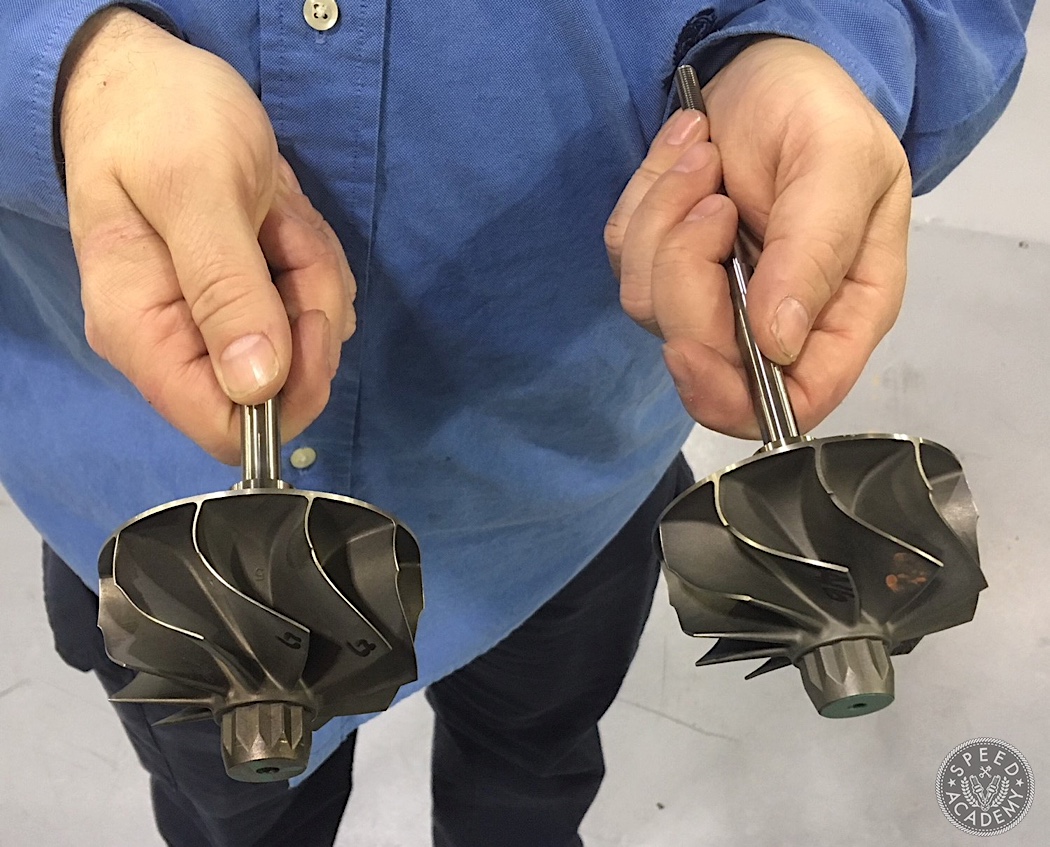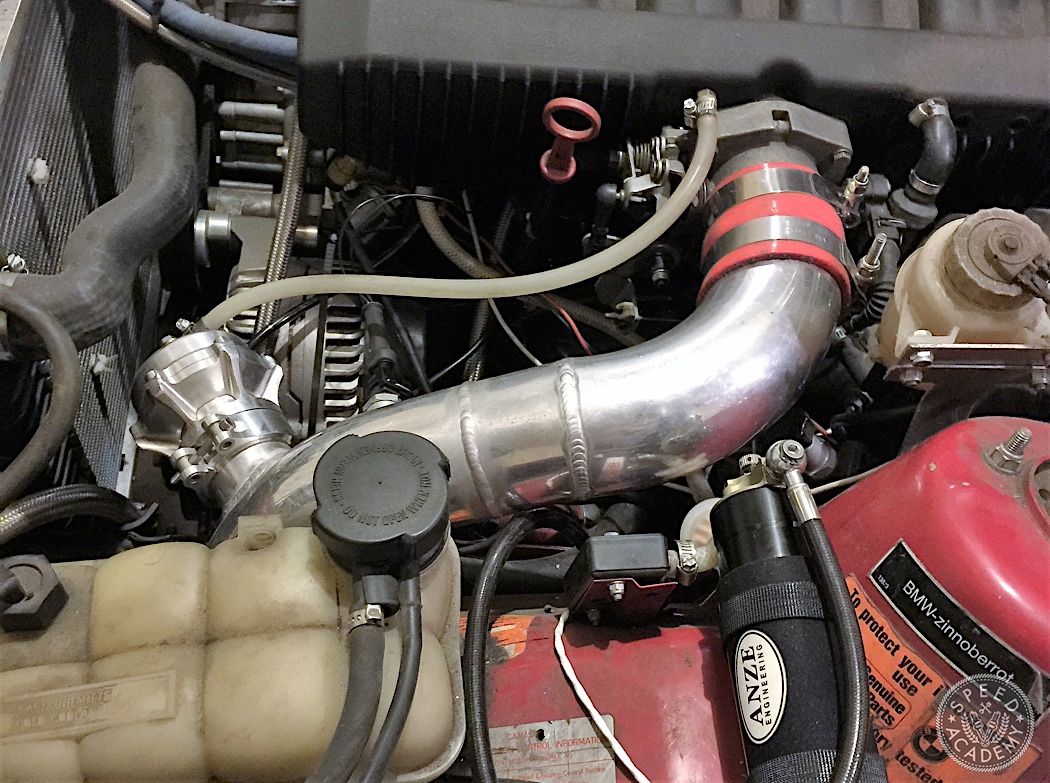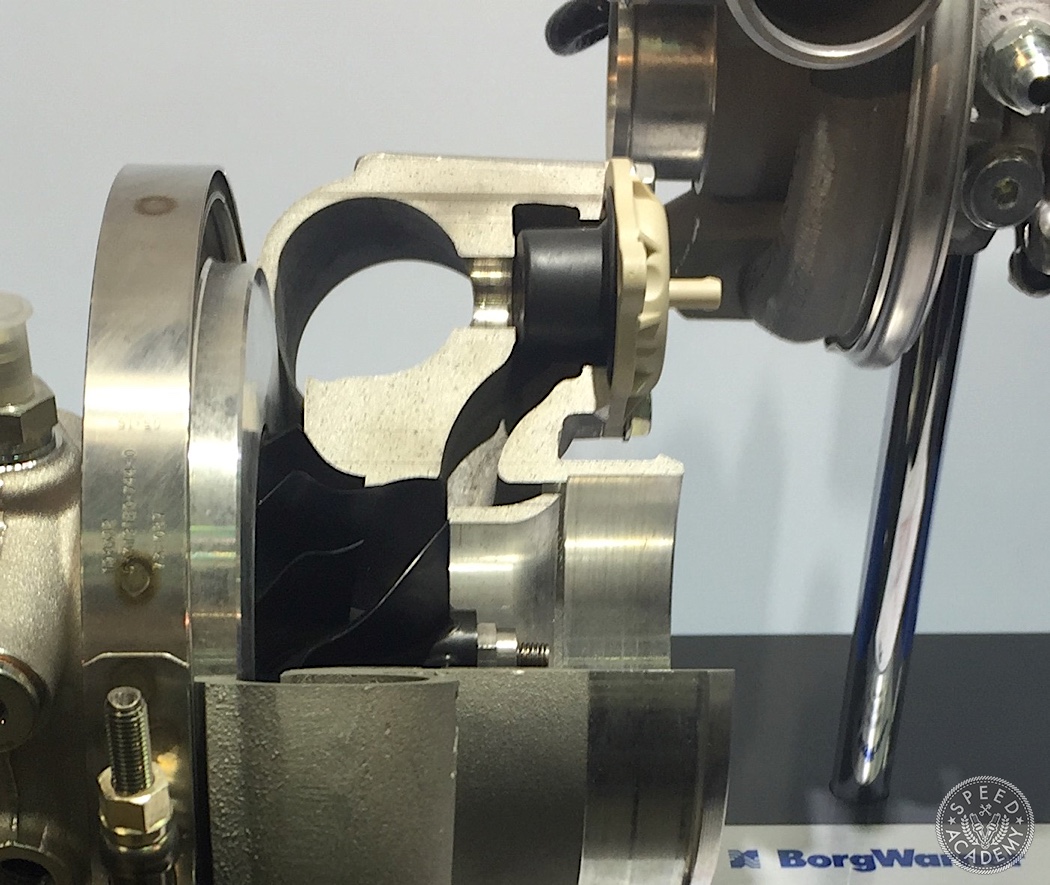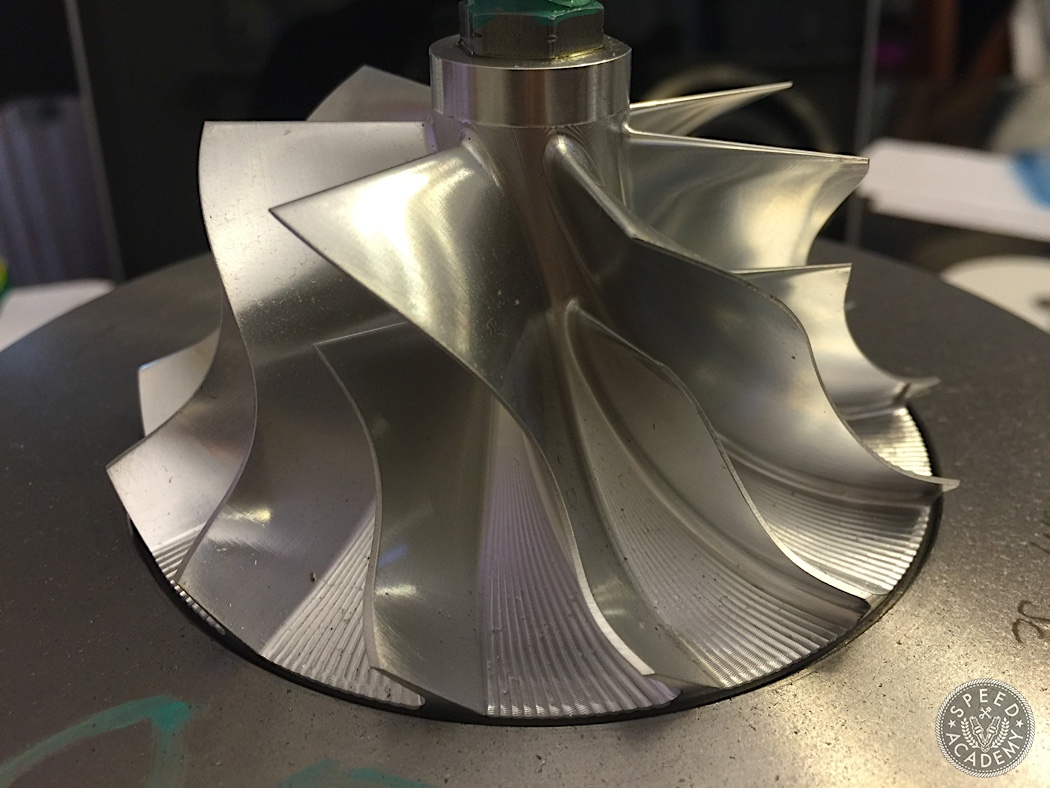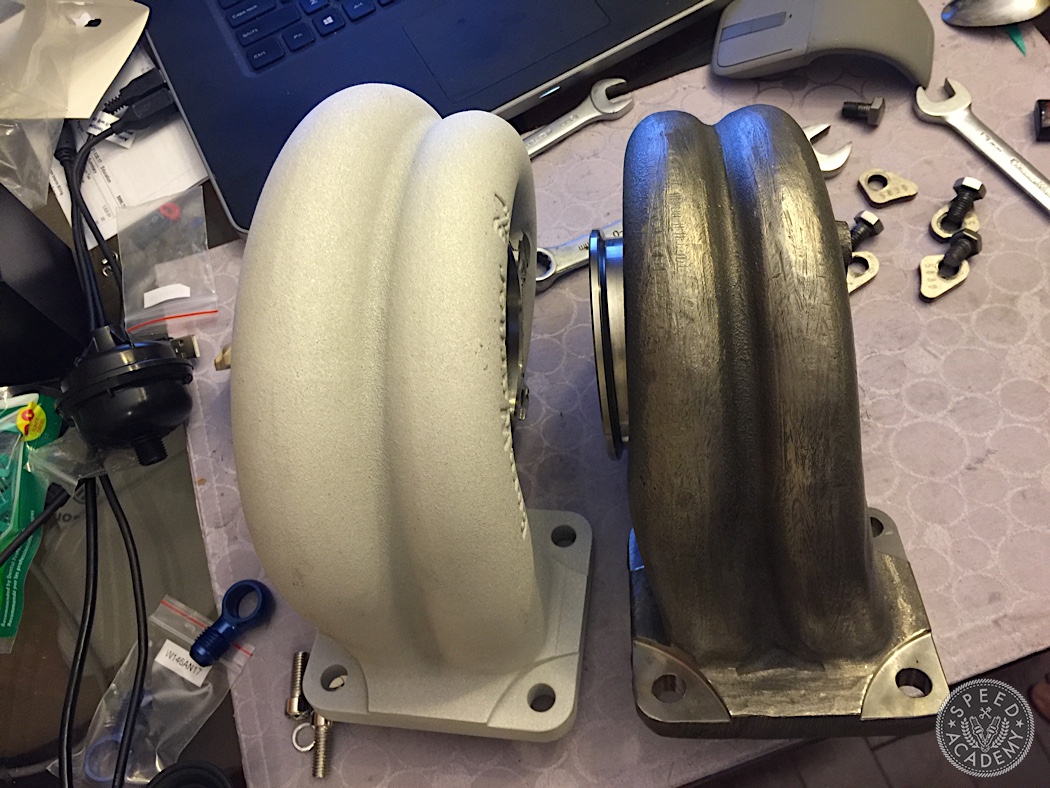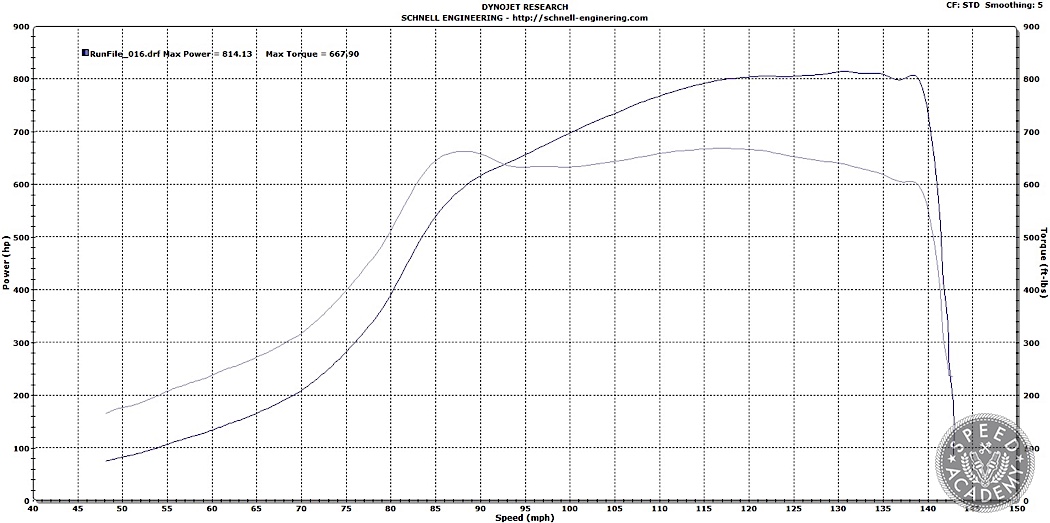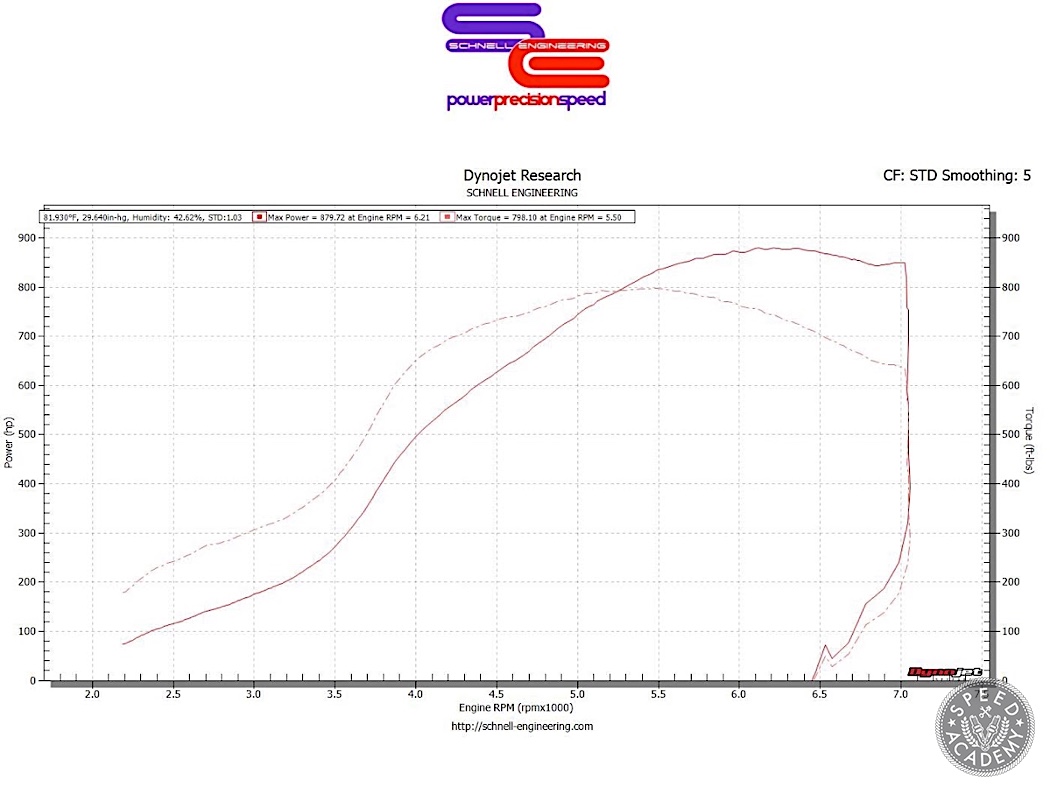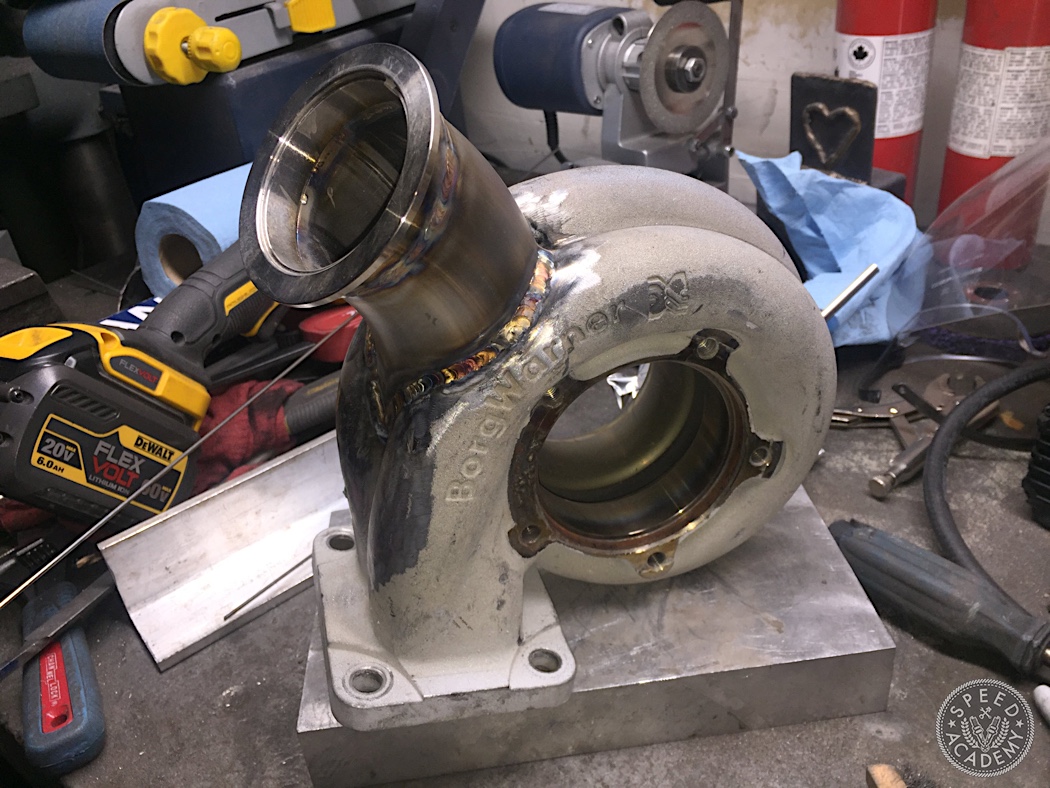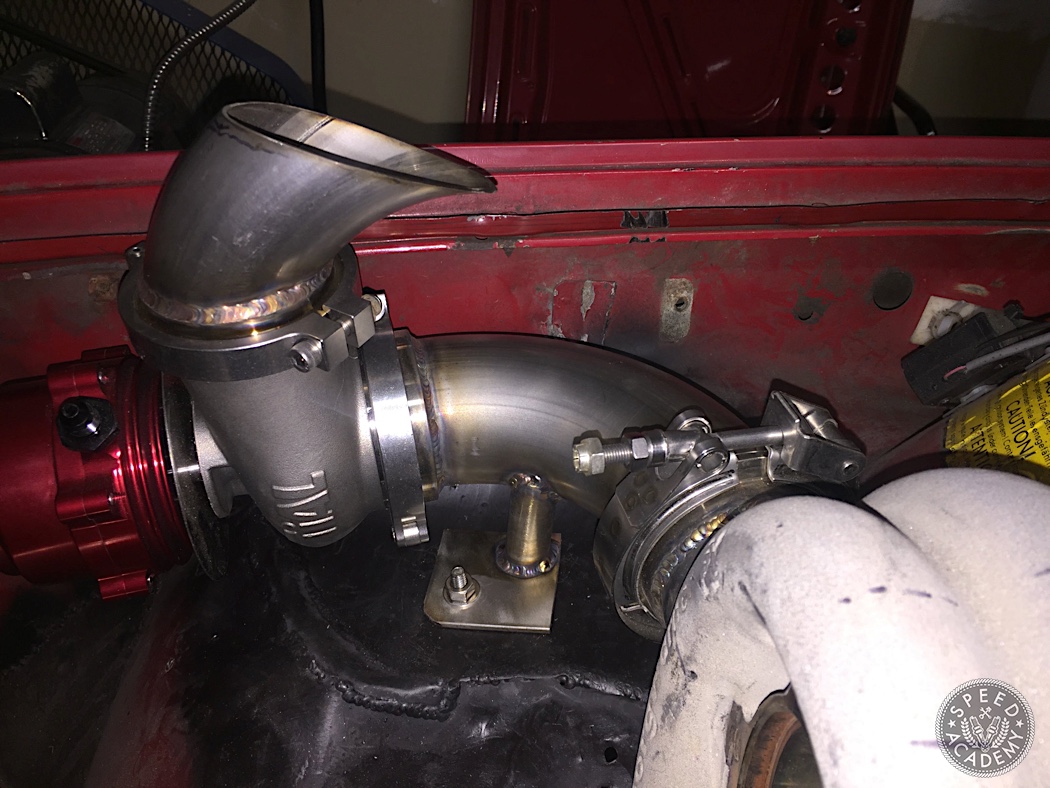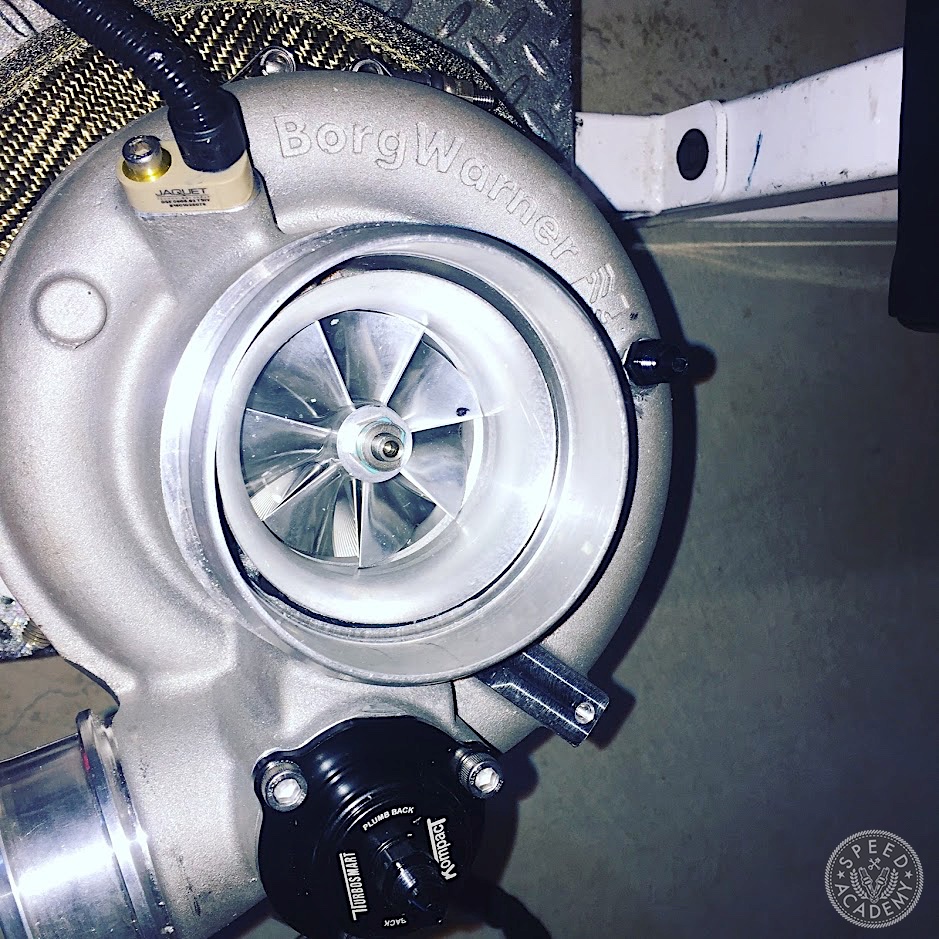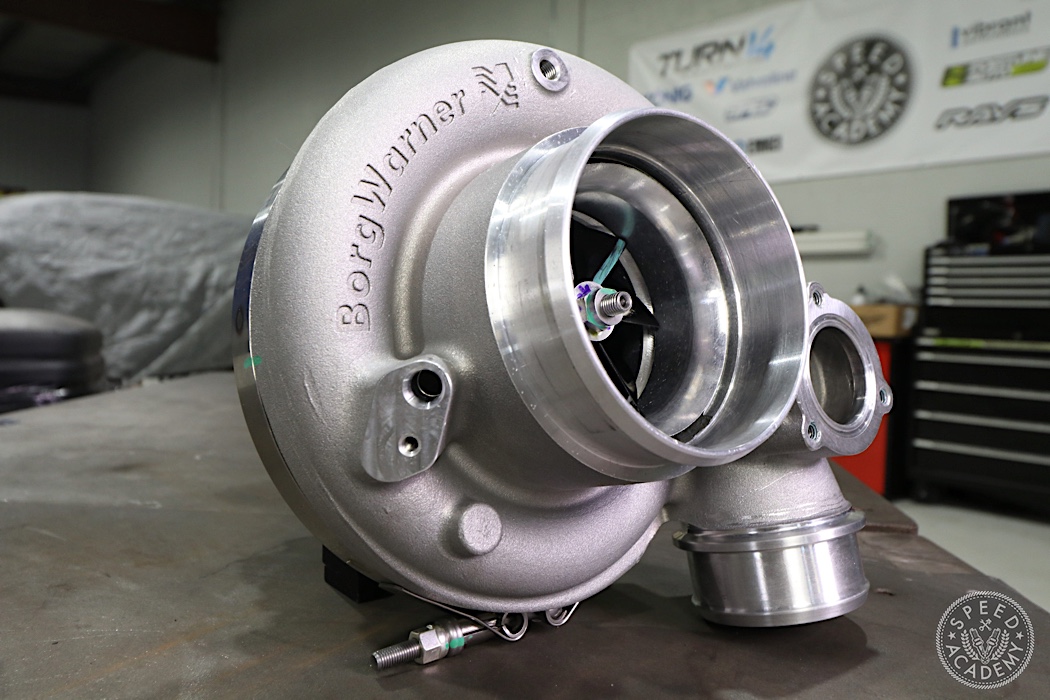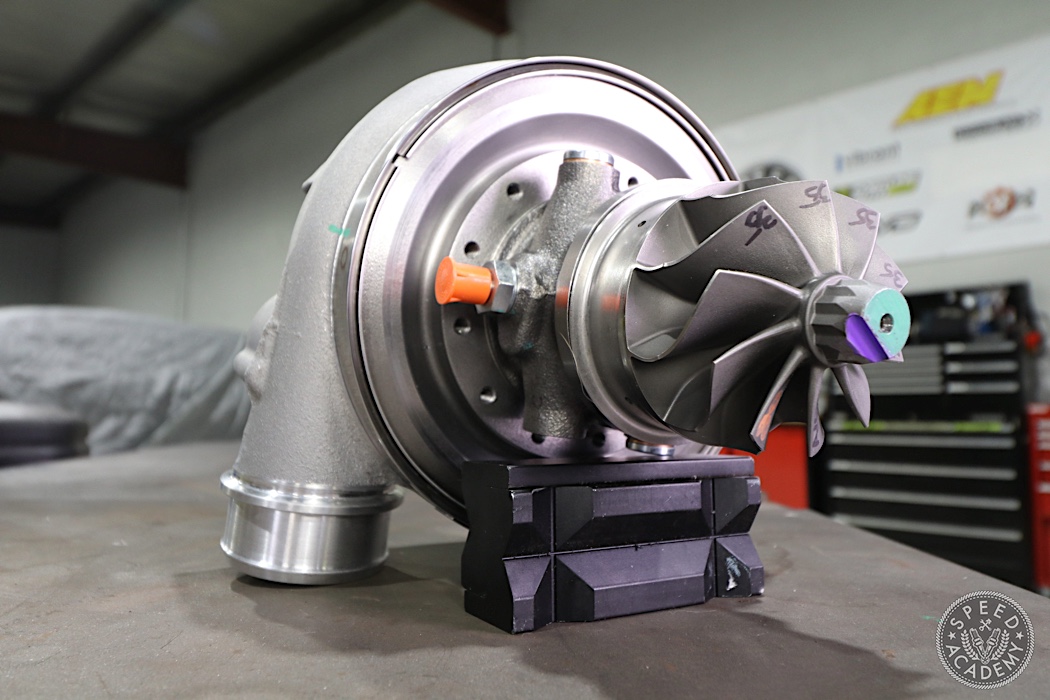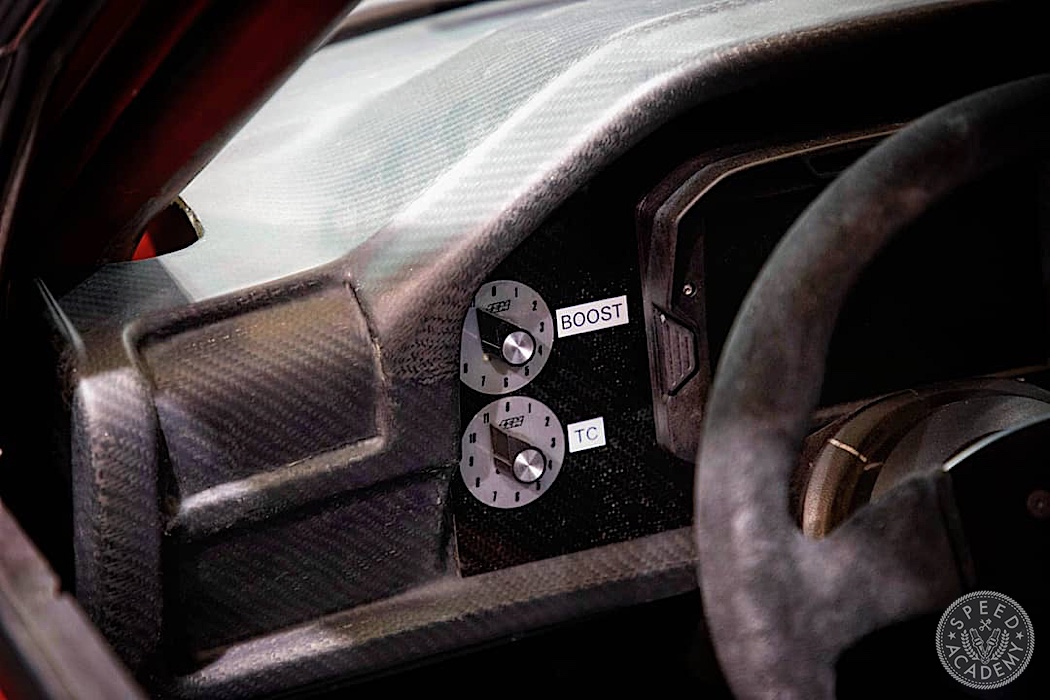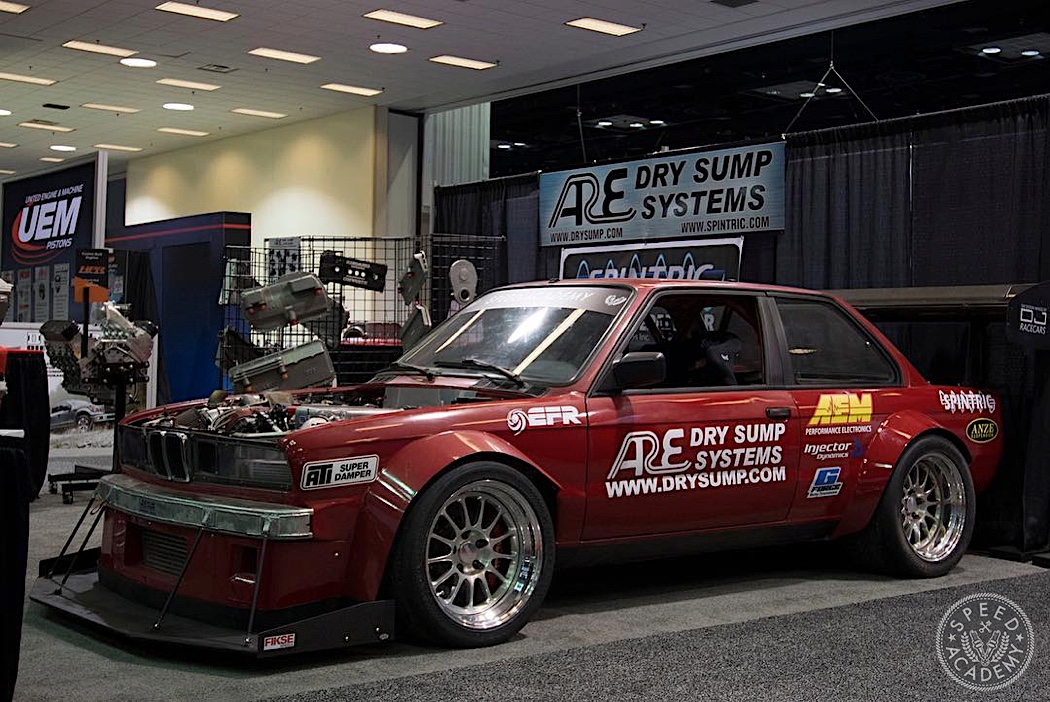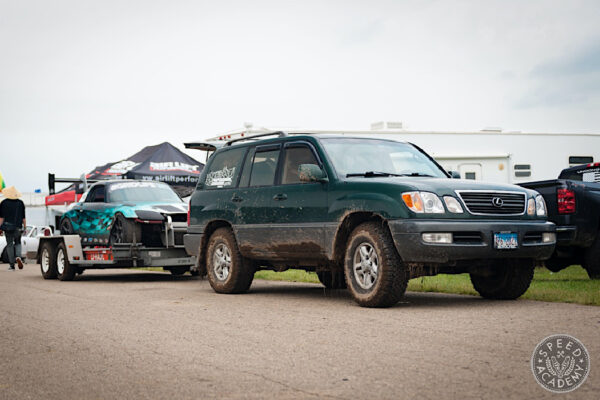ENGINEERED FOR RACING
Now that I knew what I wanted, I started hearing about a new line of turbos coming from BorgWarner. I had known about the company from their OEM reputation, as well as some of my friends who refuse to even consider anything but the AirWerks turbos since the mid-2000s for their quality and performance. But there were whispers of a new line called EFR – Engineered For Racing. I inquired further and the focus seemed to be on the one thing that my big turbo left me wanting for – improved transient response.
The solution seemed to focus on the turbine wheel. The compressor wheel is aluminum and there is not much to be saved there but the turbine wheel is typically made out of Inconel – a fancy Nickel superalloy with properties similar to stainless steel. It’s extremely resilient and maintains its strength at high temperature, like stainless steels but even more so. But like steel, it’s heavy.
Initially, this actually didn’t make sense to me. If inertia is really the enemy, then in transition, my instinct said that it should help because the added mass should act like a flywheel, letting the turbo maintain its RPM for longer in the on-off-on throttle transition through a corner. But in practice, the air resistance of the compressor and turbine when off-throttle, as well as the mechanical drag, are much greater than the inertia, even than that of the Inconel wheel. So the turbo will slow down no matter what you do, and the battle becomes getting the turbo back up to speed when you transition back to power.
The EFR design does this in two major ways. The first one is the feather-light alloy of Titanium and Aluminum called gamma Titanium aluminide. What this stuff really means is that the wheel weighs less than half of the Inconel counterpart. I’ve played with both versions at their PRI booth (pic above) every year since I’ve been going and it never gets old. I especially enjoy taking friends there who haven’t been before and letting them hold the two at the same time. Reading about it and watching videos is one thing but holding the two wheels in your hands makes it instantly obvious why the EFR would get back up to speed drastically quicker than the typical Inconel turbo. The initial reaction is that even though they look pretty much the same, one of them must be cardboard.
But there is another really cool ingredient. All of us turbo nerds love the sound of a loud blow-off valve. When I was first doing a few pulls around the neighborhood testing my setup, the neighbour’s kids were aping the noises from my blow-off valve for a long time after I was done. But what you’re hearing is the intake tract (from the turbo to the throttle body) that the turbo just worked so hard to pressurize, deflating.
The blow-off valve is just like the safety valve in a pressure vessel, which is designed to vent the pressure when it exceeds the pressure that the valve opens at. But the blow-off valve has a pressure source on the other side, from the intake manifold. So as long as the pressure on both sides is the same, it will stay closed. But if you close the throttle, you reduce the pressure in the intake manifold and the blow-off valve opens to balance the two sides.
Why do we do this? Because when you close the throttle, you cap off the outlet for the turbo compressor but it continues to pump air. This sudden stop of airflow causes the compressor blades to stall, just like the wing on an airplane, and the pressure spits back up the compressor. This is a violent event and at best it shortens the life of the turbo, or it can cause a catastrophic failure. So the blow-off valve opens when you close the throttle and relieves the pressure.
This is an effective way to protect the turbo, but it’s crude. All we really need to do is give the excess pressure that the compressor is generating a place to go. Enter the bypass valve. The EFR design incorporates the blow-off valve into the compressor cover. So instead of depressurizing the entire intake tract, the compressor just circulates the air back to the inlet and recycles it. So when you open the throttle again, you’re not building up from zero.
The bypass valve opens much the same way the blow-off valve would, except you can see here that rather than venting to atmosphere it vents the compressor output back to the inlet.
BY THE NUMBERS
Once I did my homework on what made the EFR turbos special, I knew I had to try one. The comparable turbo to mine was the 9180 and MatchBot agreed. It also suggested that I would need to go with a larger turbine housing for my upper power goals. I was currently running a 1.06 and MatchBot recommended that I get the 9180 with a 1.45 housing. I was a bit worried about it adding too much lag but that would prove to be a non-issue.
My 9180 arrived and went straight to Butters the Corgi, who always gets the whiff of first refusal of all my new toys.
I swapped out the housing from 1.05 to 1.45. The BW stainless steel housings are amazing but the 1.45 housing is so huge that installing it takes some getting used to.
First, we were off to the dyno. I wasn’t looking to pick up any power, as the turbos were almost identical in size but I still wanted to ensure that the motor was well tuned before heading to the track. I was in for quite a surprise. I’ll let the numbers/graphs tell the tale.
My original 68mm turbo, we pushed it for all it had (a bit of wheel slip on this pull but it was the highest we recorded).
And now with the BW 9180. We later dialled in the boost control and peak torque hit at a mind-blowing 850 lb/ft but we had to taper it to redline so the peak power was about the same. We had to do this to control turbo RPM. More on this later.
Speaking of boost control, with the 4” exhaust and the 1.45 housing, the turbo had so little back pressure that my wastegate basically became a noise maker. I had the typical 90-degree takeoff from the collector to the wastegate and without backpressure these don’t do anything. So I welded an elbow with a smooth path right to the big housing and off to the giant Tial V60 wastegate, finding space for which proved “interesting”.
With this setup, though, I was able to dial in a rock solid 12psi to 30psi at will.
But while the stunning power bump was certainly welcome, this wasn’t what I was really after. I was after a faster responding turbo of the same size. I’ll skip the superlatives and go straight to the results to show you what I felt, with my old turbo on the left, and EFR on the right.
In transition, the throttle is closed. Notice that the manifold pressure is higher with the EFR. My engine doesn’t use an idle control valve, so the throttle stays cracked open. This gives you a hint that behind the throttle plate, there is still some residual pressure. This isn’t a problem with the right engine calibration, since if done right, the ECU detects that it’s in overrun and cuts fuel.
I start opening the throttle. With the EFR I can commit to full power when I think the car is ready, and not roll it on pre-emptively, trying to time the transient lag.
You can already see the big EFR is re-spooling almost as fast as I open the throttle – remember that this is also with a 1.45 turbine housing, vs 1.06 on the left! But after that, things really get interesting.
My old turbo needed over a second of wide open jam to get back up to about 24 psi, while the 9180 was at 27 in under a second and still going. You can clearly see the difference in the slope of the boost curve how quickly it gets back up to speed, with no ramping (it’s almost a straight line, not a curve). The difference behind the wheel is drastic! The car now felt like it was sucking me out of the corners as soon as I got back on the gas. I really didn’t think it was possible for a turbo this big to behave this way but the data doesn’t lie and I became a believer!
WITH POWER COMES RESPONSIBILITY
I mentioned that with dialled in boost control, we were able to get the car to put down over 850 lb/ft but couldn’t maintain boost through the power band as the turbo RPM was getting high. I also mentioned earlier that the EFR turbine wheel is made out of gamma Titanium aluminide. It actually grows stronger as it heats up and is happy operating in the typical temperature ranges that a boosted engine will generate in the exhaust. But it has one primary drawback, besides cost and manufacturing complexity: low ductility. Simply put, it’s brittle, especially when cold. Nickel superalloys like Inconel are over twice as dense (read: heavy) but they can put up with abuse.
Gamma Titanium aluminide has been in development for a few decades but it didn’t really start being adopted by the Aerospace industry until the 2000s. The GE engine powering the Boeing 787 uses gamma TiAl turbine blades, and a version is coming for the 777X. And it’s in the BorgWarner EFR turbos. But while it is very well suited to these applications, both thanks to the mechanical properties and light weight, the material is still ultimately less forgiving to abuse than Inconel. This isn’t as much of a problem for the smaller EFRs. It’s like swinging a weight on the end of a rope – it’s much easier to swing it quickly when the rope is short. But to spin it at the same RPM with a long rope requires a lot of force. This is the centripetal force experienced by the turbine blades and the larger the wheel (longer rope), the greater the force, potentially leading to failure. So this is especially important to consider with the large EFRs like my 9180.
BorgWarner goes to great lengths to test and document the limits – I’m told their destructive testing lab looks scary from all the battle scars. They are explicit about the RPM limits of the EFR turbos but sadly, it seems some people didn’t heed this and were overspinning them to the moon the way they were used to doing with traditional Inconel turbos, reporting failures, and blaming the design. In reality, there is nothing wrong with the design, but you do need to operate within the design constraints. It’s a little like using a micrometer as a welding clamp and complaining that it broke.
To make sure I didn’t do this, I installed the speed sensor that BorgWarner offers. In my opinion, these should not be optional, especially on the larger EFRs so that there is no ambiguity left for buyers about whether or not this is an important concern.
The sensor was easy to install, you just have to carefully finish drilling a ¼” hole that BorgWarner have started on the cover and ensure it’s deburred on the side of the compressor wheel.
If you have an ECU that supports a digital input, you just need to do some basic arithmetic based on the specs supplied with the sensor and your turbo (to factor the number of compressor blades into the equation) and you’re all set. My old ECU didn’t have this and my dad built me a circuit that’s similar to what is offered by Full-Race, that converts the digital frequency to a 0-5v analog signal that I could log and configure safeties against.
The 9180 EFR needs to be kept below 116,000 RPM. We made sure that this was the case.
As a result, while we were able to make diesel locomotive levels of peak torque, it tapered to red line as the power built so we didn’t overspeed the turbo.
GO BIG OR GO HOME
In the past few years, I’ve been drooling over a new tease at the BorgWarner booth at PRI – a 74mm version of my 9180! I first spotted it in 2016.
The main reason I was so excited is this compressor map. What it shows is that I could run this turbo like my 9180 but without tapering boost to redline. This means that it will let me uncork my engine at the top end, maybe just set it to a flat 750-800 lb-ft of torque at the wheels, which adds up to a really fun figure at my 7200-7500RPM redline (in the neighborhood of 1000-WHP).
This year at PRI, they officially announced the release of this beauty, calling it the 9280. My 9180 supercore went up for sale and with them now arriving at distributors, I got my hands on a 9280 as soon as I could!
In the next episode, I will report back on installing it in my car and later this spring and summer, hit the dyno and racetrack, along with my new AEM Performance Electronics hardware. I’m really looking forward to dialling in the 4-wheel traction control, especially the timing retard based strategy, which I’ve never had before. Together with the proven boost control of my setup (and the AEM Infinity ECU’s strategies, like boost by gear and TPS), it should make for some really exciting driving when Dave and Pete join me at Mosport! Did I mention that the E30 now has 315/345 Hoosier A7s?
To be continued…
